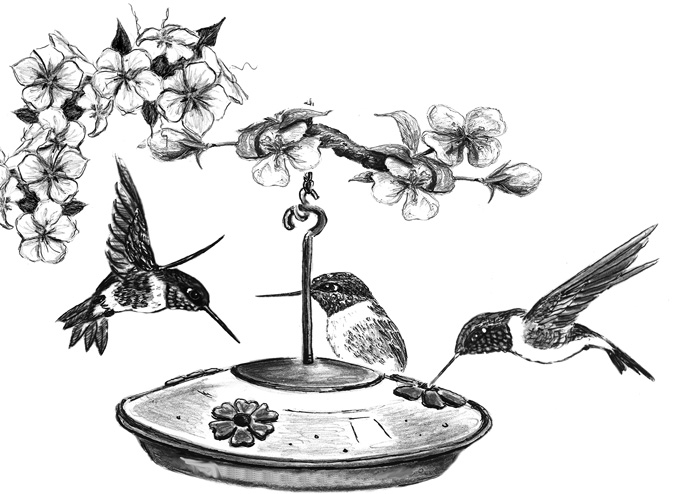
Dear Bird Folks,
We were just about to put out our hummingbird feeder and realized that the only sugar we have (to make the solution with) is raw sugar. Is it okay to use raw sugar for hummingbirds?
– Elizabeth, Provincetown, MA
I remember that, Elizabeth,
Years before proper eating became fashionable, the people who dared to eat better were called “health nuts,” and my mother was the queen of those nuts. She bought wheat germ in fifty pound sacks and even tried to get the priest in her church to use communion made from whole wheat. And instead of bedtime stories from Disney or Dr. Seuss, my mother read us passages from Prevention magazine. It was through this magazine that she first became aware of the most evil substance ever created…sugar. My mother considered sugar to be a four-letter word (math wasn’t her strong suit). One morning I woke up and all of our sugar bowls had been replaced with honey. But it wasn’t normal honey; it was that chunky, still-in-the-comb honey. What a mess that was. For years I was the stickiest kid in school. Then one day (after perhaps being pressured by bee-loving vegans), she switched from honey to raw sugar. Today raw sugar is everywhere, but in 1964 we were the only family in town using it. I can still see the look on my uncle’s face when his sister gave him a bowl of raw sugar to use in his coffee. He just stared at it for a minute and then said, “What’s this, sand?” From then on my uncle brought his own “normal” sugar whenever he visited our house.
I’m not a sugar expert, but everything I’ve read about it suggests that raw sugar is not what it seems. First of all, it’s not really “raw.” All sugar is cooked when manufactured, so there’s nothing raw about it. Other people call this kind of sugar “natural,” which is a little ridiculous. All sugar is natural. It is claimed that raw/natural sugar (aka, sand) tastes better. That’s a possibility because raw sugar is processed less and thus retains a thin coating of tasty molasses. However, the idea that one sugar is healthier than the other is kind of silly. (Not as silly as putting that new traffic rotary in Orleans, but it’s still silly.) Too much sugar in any form is not good for you. It’s like bacon fat. It might taste good, but no matter how it’s processed, it’s still nasty old bacon fat. (Although, sugarcoated bacon fat sounds pretty good.)
Right now you might be wondering: If sugar is so bad for us why are we giving it to hummingbirds? Nature is diverse and complicated. What is detrimental to one species might be beneficial to another. For example,: crows, flies and maggots thrive on rotting carrion, but you and I should probably avoid it. Why did hummingbirds evolve to have such a need for sugar? Blame the flowers. Unlike creatures with mobility, plants remain in the same location all their lives (like your boring friends from high school). If a plant wants to spread its pollen, it must rely on the help of a third party. Sometimes pollen is spread by the wind (our yellow-coated cars can attest to that), but more often it is spread with the help of animals. Insects, bees, bats and birds all unknowingly do the spreading for them. When a hummingbird visits a flower the sticky pollen attaches itself to the bird and then is redeposited when the bird visits another flower. As compensation for all this work, the hummingbirds are rewarded with a beak-full of sweet nectar.
A steady diet of nectar, plus a few tiny insects for protein, is basically all that hummers need. Eating large quantities of sugar day-in and day-out might be unhealthy for us, but the birds can handle it. Besides, to my knowledge not a single hummingbird has ever been diagnosed with diabetes.
While the sugar content of plants can vary, most experts feel that a formula of four parts water to one part sugar is the closest to the nectar hummingbirds obtain from flowers. Authorities also say that the best kind of sugar to use is nasty old white table sugar (just don’t tell my mother). No other alternatives to white sugar are encouraged. Honey might seem like it’s a good idea, but apparently it can produce mold that is harmful to the birds. Even raw/natural sugar is discouraged (which I believe was the question you asked way back when). As I said, the less processed raw sugar retains a thin coating of molasses. Some folks believe that this little bit of molasses contains valuable minerals. It doesn’t. Oh, there are some extra minerals all right, but they are considered to be “trace” amounts. These trace amounts are certainly not enough to benefit a human. However, there is a concern that these same trace minerals may be detrimental to the tiny hummingbird, which weighs a measly three grams. How about that? They can eat all the sugar they want and still only weigh three grams. It doesn’t seem fair.
Raw sugar might not be the worst thing you can put in your feeder, Elizabeth, but why take the chance? A bigger concern is proper feeder maintenance. Remember to rinse and change your feeders every three days. Also, forget red food coloring. Most feeders have plenty of red on them already; plus ingesting food coloring is controversial, even for humans. What about the pre-made stuff that is sold in the store? I don’t use it, but I sell a lot of it. Sometimes people like to spend money on things they really don’t need…like that new traffic rotary in Orleans.